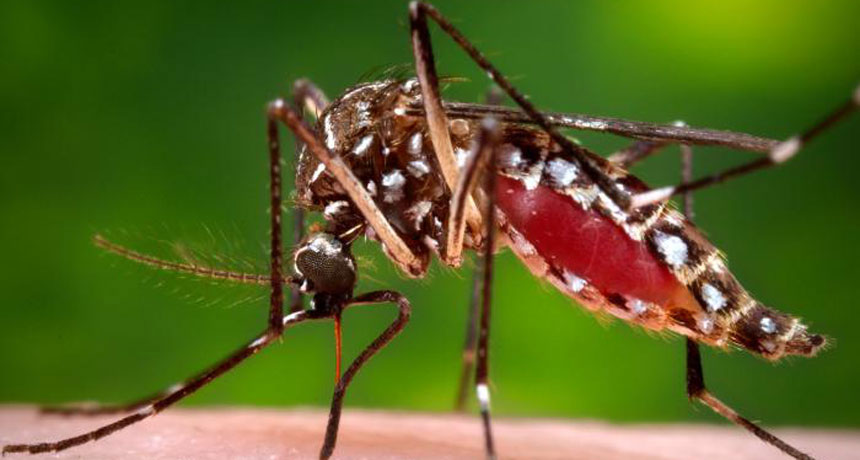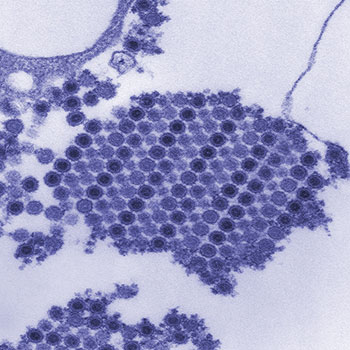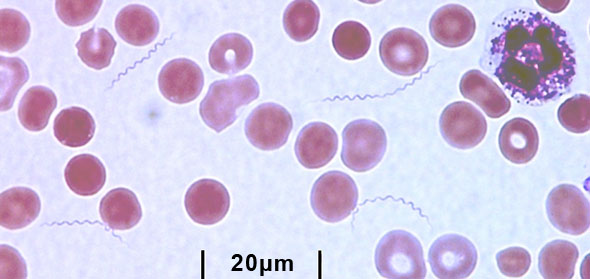A germ stopper for blood products
Safer blood platelets and plasma are coming to blood banks

Mosquitos such as this Aedes aegypti female can transmit diseases like dengue fever and chikungunya. A new system will let blood banks disarm gerns in important blood products coming from donors who may have been sick.
James Gathany
By Tara Haelle
A new treatment can inactivate germs in some of the blood products that are donated for use in transfusions. The U.S. Food and Drug Administration approved the use of this new treatment last December. Blood banks in Puerto Rico began using it right away. (A serious disease outbreak had rattled the island. And the virus responsible did not show up during blood screening.) This month, blood banks on the U.S. mainland will begin start to use the new treatment as well.
You might think of the new system as a bug zapper. It prevents viruses, bacteria and protozoan parasites from multiplying in two components of blood — plasma and platelets. Blood banks commonly supply both products for transfusing into people who are very sick or seriously injured.
There are several components to blood: Red blood cells, the best known, ferry oxygen through the body. Plasma is the fluid part. It contains proteins that help fight diseases. Platelets will help the blood clot to prevent bleeding.

The products provided by U.S. blood banks are already very safe. A person has to be fairly healthy for blood banks to accept them as a donor. Still, blood banks screen their donated blood for certain diseases. The problem: new diseases can emerge before a test for them exists.
That’s what happened when the West Nile Virus emerged, notes Harvey Klein. He’s chief of blood-transfusion medicine for the National Institutes of Health Clinical Center in Bethesda, Md. “People were infected before a test could be licensed and blood could be screened,” he says.
In 2002, three years after West Nile cases first showed up in the United States, scientists documented 23 cases of people who became infected with the virus through transfusions of blood components. Before then, scientists hadn’t realized the virus could infect people through transfusions.
Many more probably received infections than those reported, Klein says. Banks did not begin screening blood for West Nile Virus until July 2003. If there had been a way to inactivate viruses at the time, “West Nile never would have been transmitted by blood transfusion,” Klein observes.
Right now, two worrisome mosquito-borne diseases have begun to show up in the United States. Chikungunya (CHIHK-uhn-GUN-yuh) causes flu-like symptoms that can last a week or so. Later, excruciating joint pain may develop and last weeks to years. With no cure, this disease must just run its course. In the last decade, more than 3 million people around the world have learned firsthand the misery it can cause.

Viruses cause both diseases. No blood-screening tests currently exist to identify either of these viruses in blood. Meanwhile, mosquitos that carry these germs have been moving farther north as the climate has been warming.
“We’re in central south Florida on the coast, and there’s chikungunya coming in,” says Scott Bush. He runs the SunCoast Blood Bank there. Of these two tropical diseases, “dengue is a bigger threat,” he says. “And this new [Intercept] system takes care of that too,” he notes with some relief.
How Intercept works
William “Obi” Greenman is the president of Cerus, the company that makes Intercept. The idea for it came from chemicals called psoralens (SOR-ah-lens), he says. These are natural insect-killing chemicals. They can be found in the skin of some fruits and vegetables, such as beets, celery, lemons and limes. An insect that eats the skin of these vegetables won’t die right away. The chemical has to be activated by light. A bug will die only if it has ingested a lot of psoralens and then goes out into the sunlight, Greenman notes.
Engineers altered versions of these psoralens to work in blood. This created a new compound called amotosalen.
Technicians add the compound to blood plasma or platelets. Then they shine ultraviolet light onto the blood product. The compound works its way into any cells in the blood, including any germs. The light causes the molecules of the compound to attach themselves diagonally inside a cell’s nucleic acids, such as DNA or RNA. That gums up the genetic material so that it no longer can copy itself. The process takes 15 minutes for plasma and 4 to 16 hours for platelets. This renders any germs harmless.
“Blood doesn’t have any functioning nucleic acids,” Greenman explains. Red blood cells lack a nucleus, which is where any DNA or RNA would be. And plasma and platelets are not complete cells. “So by targeting the nucleic acids in a blood product, you can target pathogens in particular,” Greenman said. Pathogens are disease-causing agents, such as bacteria and viruses.
During a chikungunya outbreak in the U.S. territory of Puerto Rico, last year, the Red Cross had to stop taking local platelet donations. The organization was concerned these blood products might be infected with chikungunya or dengue virus. But the Red Cross was able to resume platelet collections on this Caribbean island once blood banks there began using Intercept.
The new system offers benefits even in areas without these tropical viruses. Bacteria pose the biggest risk of infections from transfused platelets, notes Susan Stramer. She’s vice president of scientific affairs at the American Red Cross in Gaithersburg, Md. Testing platelets for bacteria takes up to two days. That’s a long time for these blood products, which are good for only five days. Testing for other infectious diseases takes blood banks less than one day, she notes. Using Intercept to inactivate germs can save a day of testing. And this will extend the shelf life of valuable platelets.
Still, even Intercept cannot eliminate all risks from blood. Certain types of bacteria form spores that have an especially tough coat, which the psoralen-like chemical cannot enter. And some viruses protect their genetic material too well for the molecule to get through. Overall, however, the system can inactivate 99.99 percent of the dangerous germs it can penetrate, Greenman says.
“It’s still not 100 percent effective,” says Bush of the SunCoast Blood Bank. “But this system comes pretty darn close.”
Power Words
(for more about Power Words, click here)
bacterium (plural bacteria) A single-celled organism. These dwell nearly everywhere on Earth, from the bottom of the sea to inside animals.
blood bank A facility that collects blood from healthy donors to be used — transfused — into people who are sick or who have lost a lot of blood due to trauma.
chemical A substance formed from two or more atoms that unite (become bonded together) in a fixed proportion and structure. For example, water is a chemical made of two hydrogen atoms bonded to one oxygen atom. Its chemical symbol is H2O.
chikungunya A tropical disease that has been crippling large numbers of people in Africa and Asia. It’s caused by a virus that is spread by mosquitoes. It has recently been spreading widely throughout warm nations. Since 2005, more than 3 million people have suffered through its initial flu-like symptoms. A large share may also go on to develop intense pain in their muscles and joints that can last months to years. There is no cure or vaccine.
climate The weather conditions prevailing in an area in general or over a long period.
clot A collection of blood cells (platelets) and chemicals that collect in a small region, stopping the flow of blood.
dengue fever A potentially lethal infectious disease transmitted by mosquitoes. No vaccine yet exists to prevent infection with the virus responsible for the disease, which causes high fevers, severe headache, joint pain, pain behind the eyes, rash, bone pain and sometimes mild bleeding. A more severe form of the disease, known as dengue hemorrhagic fever can cause uncontrolled bleeding if not treated right away.
DNA (short for deoxyribonucleic acid) A long, double-stranded and spiral-shaped molecule inside most living cells that carries genetic instructions. In all living things, from plants and animals to microbes, these instructions tell cells which molecules to make.
Food and Drug Administration (or FDA) A part of the U.S. Department of Health and Human Services, FDA is charged with overseeing the safety of many products. For instance, it is responsible for making sure drugs are properly labeled, safe and effective; that cosmetics and food supplements are safe and properly labeled; and that tobacco products are regulated.
genetic Having to do with chromosomes, DNA and the genes contained within DNA. The field of science dealing with these biological instructions is known as genetics. People who work in this field are geneticists.
germ Any one-celled microorganism, such as a bacterium, fungal species or virus particle. Some germs cause disease. Others can promote the health of higher-order organisms, including birds and mammals. The health effects of most germs, however, remain unknown.
hemoglobin A molecule that binds to oxygen in the blood, carrying it around to tissues.
infection A disease that can spread from one organism to another.
infectious An adjective that describes a type of germ that can be transmitted to people, animals or other living things.
influenza (or flu) A highly contagious viral infection of the respiratory passages causing fever and severe aching. It often occurs as an epidemic.
molecule An electrically neutral group of atoms that represents the smallest possible amount of a chemical compound. Molecules can be made of single types of atoms or of different types. For example, the oxygen in the air is made of two oxygen atoms (O2), but water is made of two hydrogen atoms and one oxygen atom (H2O).
National Institutes of Health, or NIH This is the largest biomedical research organization in the world. A part of the U.S. government, it consists of 21 separate institutes — such as the National Cancer Institute and the National Human Genome Research Institute — and six additional centers. Most are located on a 300 acre facility in Bethesda, Md., a campus containing 75 buildings. The institutes employ nearly 6,000 scientists and provide research funding to more than 300,000 additional researchers working at more than 2,500 other institutions around the world.
nucleic acids The genetic material of all life on Earth. It’s usually found in the form of DNA and RNA.
outbreak The sudden emergence of disease in a population of people or animals. The term may also be applied to the sudden emergence of devastating natural phenomena, such as earthquakes or tornadoes.
pathogen An organism that causes disease.
pigment A material, like the natural colorings in skin, that alter the light reflected off of an object or transmitted through it. The overall color of a pigment typically depends on which wavelengths of visible light it absorbs and which ones it reflects. For example, a red pigment tends to reflect red wavelengths of light very well and typically absorbs other colors. Pigment also is the term for chemicals that manufacturers use to tint paint.
plasma The colorless fluid part of blood.
platelets The smallest of blood cells, their role is to search for signs that a vessel has been damaged. Then they congregate at the site of damage and transform themselves, growing long tentacles. There they link together, creating a clot to plug any hole — stemming the potential loss of blood.
protozoan (plural: protozoa) Any of many types of single-celled organisms, most of them too small to be seen with the unaided eye. They include amoebas, parameciums and many others. Some can cause disease in humans and other animals.
psoralens A family of compounds that can absorb ultraviolet light. They occur naturally in the skin of many fruits and vegetables, where they can ultimately poison insect pests. Some therapeutic drugs have also been based on these compounds.
red blood cells Colored red by hemoglobin, these cells move oxygen from the lungs to all tissues of the body.
RNA A molecule that helps “read” the genetic information contained in DNA. A cell’s molecular machinery reads DNA to create RNA, and then reads RNA to create proteins.
transfusion The transfer of donated blood or blood products into the circulatory system of a person or animal.
ultraviolet A portion of the light spectrum that is close to violet but invisible to the human eye.
vaccine A biological mixture that resembles a disease-causing agent. It is given to help the body create immunity to a particular disease. The injections used to administer most vaccines are known as vaccinations.
virus Tiny infectious particles consisting of RNA or DNA surrounded by protein. Viruses can reproduce only by injecting their genetic material into the cells of living creatures. Although scientists frequently refer to viruses as live or dead, in fact no virus is truly alive. It doesn’t eat like animals do, or make its own food the way plants do. It must hijack the cellular machinery of a living cell in order to survive.
West Nile disease A disease caused by a virus that is transmitted by mosquitoes. Most people develop no symptoms. But about one in five infected people will get a headache, body aches, joint pains, vomiting, diarrhea, fever or some rash. A very small share of infected people will also develop coma, seizures or paralysis.







